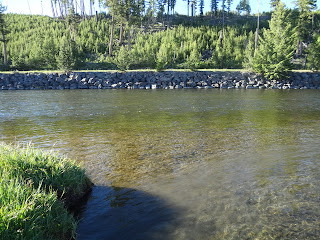 |
| Brown Trout, Gallatin River below Specimen Creek |
Close-to-home
fishing on the Firehole is over for now. The water has warmed and dropped, the insect
hatches over. They will resume in September.
Fishing now is on Yellowstone’s
icy rivers that finally come into their own in July. The Lamar and Soda
Butte in the Park’s northeast corner; the Gallatin on the flank of the Park
north of West Yellowstone; the Yellowstone River between the lake and the
falls. All are a 1-2 hour drive from Old Faithful. I have explored them in
the past couple of weeks.
 |
| Fishing Soda Butte Creek |
The
Gallatin is a favorite, a classic, high mountain stream that never stops its
mad dash over a cobble and boulder bottom for more than thirty miles. It isn’t
easy fishing with the current and uneven bottom, but it is fun seeking out the
soft pockets and seams where trout lie.
 |
| Cutthroat Trout, Soda Butte Creek |
The Lamar
River and Soda Butte Creek are cutthroat trout country. I fished both of them
briefly July 12-13 when Heidi and I spent our weekend there (cabins at Mammoth
Hot Springs and outside the Park’s Northeast Entrance in Cooke City).
 |
| Cutthroat Trout, Lamar River |
Fishing these
two streams is a real treat. I caught a nice cutthroat trout out of each; no
fancy technique, just streamers and nymphs.
Then,
there is the Yellowstone River from where it leaves Yellowstone Lake on down to
the falls. It stays closed to fishing until July 15th to protect the
spawning run. Its fabled cutthroat trout
population has been decimated the past two decades by non-native lake trout
into Yellowstone Lake (introduced accidentally or maliciously, no one knows).
Still, the
river-resident trout are present, and run big. Observing many big trout lying
below Fishing Bridge at the lake’s outlet was an encouraging sign that the lake
trout control program is having a positive effect.
 |
| The Yellowstone River just below Yellowstone Lake |
I fished
the Yellowstone July 18th on a day off. The river is huge (3000 cfs
discharge coming out of the lake), the current fast. The sight of all those big
fish at Fishing Bridge and a few big ones cruising the banks kept me going. So
did the proliferation of bugs in the air all day long. Wow, what a rich,
healthy trout river the Yellowstone is!
A long,
hot day of fishing had me pretty much whipped by 4 PM. I decided to spend one last
hour running nymphs slowly working downstream from Buffalo Ford. My destination
was another “Dave’s Island”, named from the 2007 trip when Dave Parker had
rolled a big cutthroat there. Four bison less than 75 yards from the riverbank gave
me pause, but I proceeded. What the heck.
After
several hundred yards of featureless bottom, several large boulders lying
midstream caught my eye. As my line drifted into the pocket below them, it
caught on something. The bottom, I thought at first…then, the bottom moved.
Holy smokes! I was onto a big Yellowstone cutthroat!
This fish
was even bigger than the Firehole brown I hooked back in early June. I leaned
on it hard, confident in the 8-pound leader I was running (hawser size by
stream trout standards). It ran out 100
feet, then came back toward me. The fight lasted for minutes.
The fish
was beat, up and thrashing on the surface. But it was still 60 feet away and
below me, and the river was on the fish’s side. I couldn’t gain any line
against the strong current and was unable to wade down to the fish due to deep
water. I made it to shore, hoping to regain the advantage from a rock ledge
over the pool where the fish was holding. But, the movement toward the bank
allowed the fish to go there too. By the time I made it to the ledge, the fish
had wrapped me around a log. He was off. Big river…big fish…what fun!
It was a
quarter mile through sagebrush back to the car, nervously eyeing those bison
over my left shoulder. If I was tired before, I was exhausted now. I had a bite
to eat, and started the drive home.
 |
| The Estuary on the Yellowstone River |
The road
home passes the Estuary. This is a wide, slow-moving part of the Yellowstone
River a couple miles below the lake outlet. It was early evening, and
caddisflies were everywhere. Too tired to fish, I nevertheless stopped to
observe. Rising fish began to dimple the wide, calm water up and down the bank.
A lone angler watched the proceedings too, from the comfort of his camp chair
on the bank. Promptly at 7PM, he rose and waded out waist-deep. In less than
ten casts, he hooked and landed a dandy cutthroat.
There
aren’t a lot of trout in the Yellowstone, but they are big ones. I will be back
to fish it a couple more times before all the hatches play out.



























